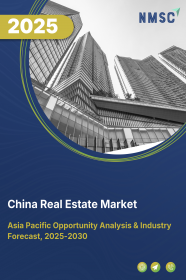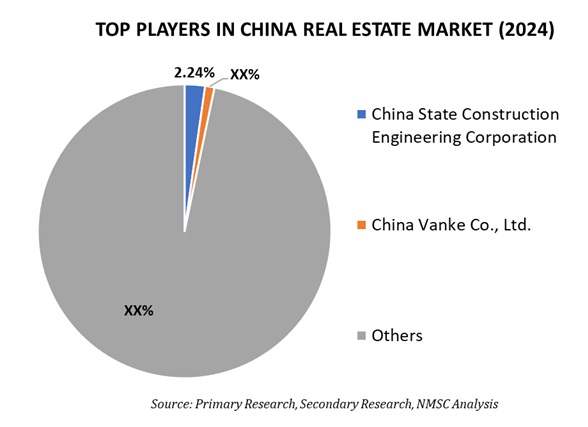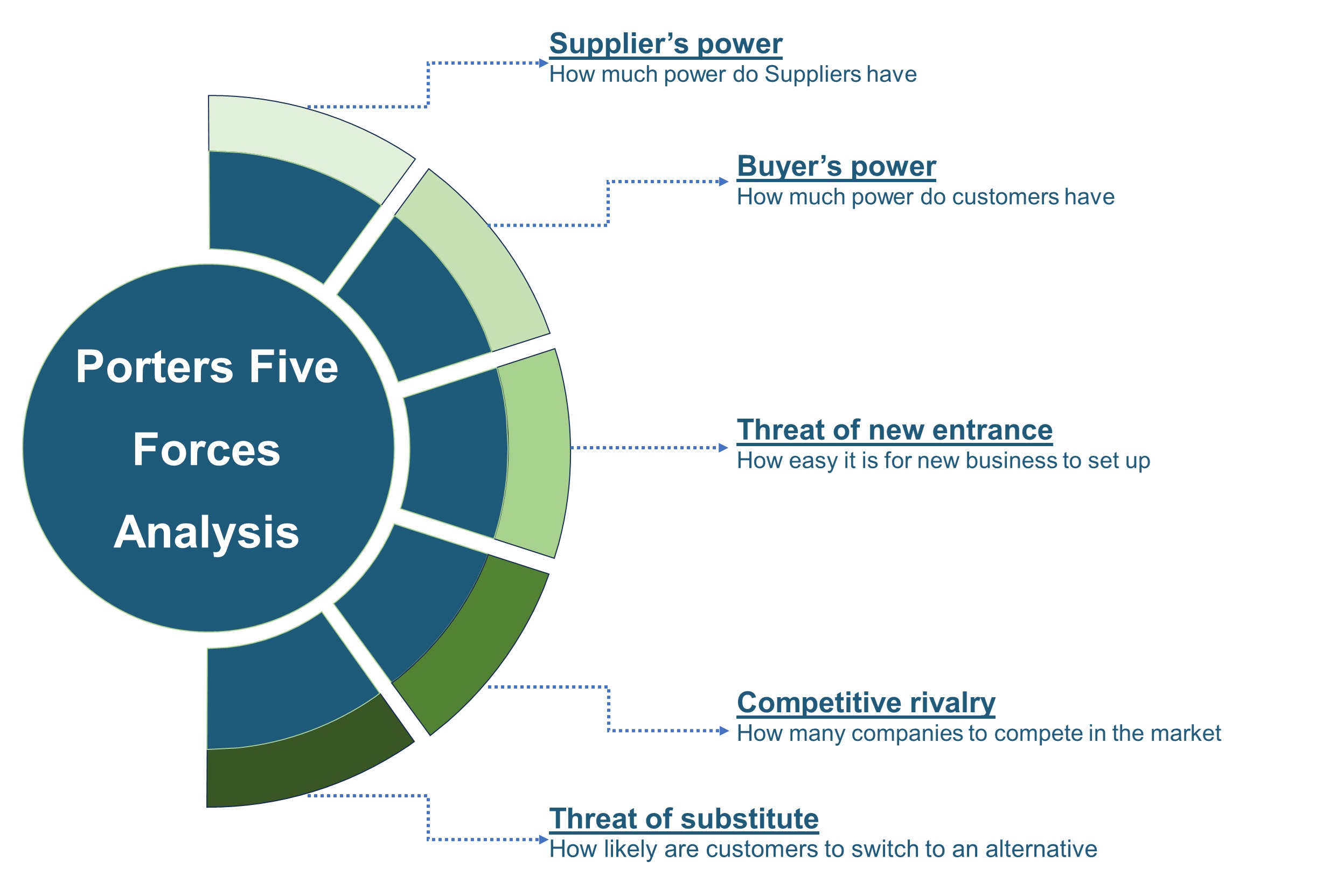
China Real Estate Market by Property Size (Small (<500 sq. ft.), Medium (500–2000 sq. ft.), Large (2000+ sq. ft.)), by Property Type (Residential, Commercial, Land, Industrial), by Business Type (Buying, Selling, Leasing, Renting and Real Estate Investment), by Ownership (Owner-Occupied Properties, Rental Properties, Co-ownership), and Others – Opportunity Analysis and Industry Forecast, 2025–2030
Industry: Construction & Manufacturing | Publish Date: 10-Sep-2025 | No of Pages: 138 | No. of Tables: 144 | No. of Figures: 89 | Format: PDF | Report Code : CM1208
China Real Estate Market Overview
The China Real Estate Market size was valued at USD 5.30 trillion in 2024 and is predicted to reach USD 6.98 trillion by 2030, with a CAGR of 3.9% from 2025 to 2030.
The factors such as increasing urbanization coupled with population growth and government investments along with growth of construction industry drive the market growth. However, stringent government regulation in China is restraining the real property industry by reducing investor confidence and slowing property demand. On the contrary, the growing demand for sustainable and eco-friendly buildings are creating new opportunities for real property sector to come up with better projects in the country.
In addition to that, the leading players such as China State Construction Engineering Corporation, China Vanke Co., Ltd., Sunac China Holdings Limited, among others, are adopting various initiates through launch of development projects and collaboration in an effort to better their market positions and expand their real property services. Developers, with advancement in sustainable construction techniques, are paying attention to building designs that focus on eco-friendliness and sustainability to address the increasing demand for green buildings leading to expansion in the real estate market of the country.
Shift Toward Urban Innovation And Smart City Development Boosts Real Estate Growth
The push for smart city development and urban modernization is a major driver of China’s real estate growth. As the government prioritizes digital transformation and infrastructure upgrades, there is a surge in demand for intelligent, efficient urban spaces that integrate housing, commercial activity, and public services. Projects involving smart grids, 5G connectivity, AI-powered building management systems, and integrated transport hubs are reshaping urban living standards, making real estate assets more attractive to investors and residents alike.
These advancements are not only improving urban efficiency but also creating new value in previously underutilized or aging urban areas through redevelopment and renewal initiatives. The integration of real estate with technology is fostering a new generation of livable, green, and digitally connected cities, further expanding real estate investment opportunities and long-term demand across both residential and commercial segments.
Growing Demand For Rental Housing And Affordable Living Options Fuels Market Shift
A notable shift in housing demand patterns is driving new growth areas in China's real estate sector. With changing demographics, delayed homeownership among younger generations, and government support for housing affordability, the rental and multi-family housing segments are experiencing strong momentum. Government programs promoting build-to-rent developments, public rental housing, and affordable housing projects are expanding the market base beyond traditional homebuyers.
This evolving demand structure is also attracting institutional investors and developers to focus on long-term rental yields and stable income streams, reducing the previous reliance on speculative sales. The rise of professionally managed rental properties and co-living models in tier 1 and tier 2 cities further reflects a structural transformation toward a more balanced, inclusive, and sustainable housing ecosystem.
Persistent Developer Liquidity Crisis Undermines Market Stability
A notable shift in housing demand patterns is driving new growth areas in China's real estate sector. With changing demographics, delayed homeownership among younger generations, and government support for housing affordability, the rental and multi-family housing segments are experiencing strong momentum. Government programs promoting build-to-rent developments, public rental housing, and affordable housing projects are expanding the market base beyond traditional homebuyers.
This evolving demand structure is also attracting institutional investors and developers to focus on long-term rental yields and stable income streams, reducing the previous reliance on speculative sales. The rise of professionally managed rental properties and co-living models in tier 1 and tier 2 cities further reflects a structural transformation toward a more balanced, inclusive, and sustainable housing ecosystem.
Redevelopment Of Old Urban Areas Unlocks New Growth Potential
China’s urban renewal strategy—focused on upgrading aging residential communities, industrial zones, and underused urban land—is creating new growth avenues for the real estate sector. Redevelopment initiatives are being prioritized in major cities to enhance land use efficiency, improve living conditions, and stimulate local economies. These projects open up opportunities for private developers, construction firms, and infrastructure providers to engage in long-term, policy-aligned investments.
With government incentives and policy support behind these efforts, redevelopment projects are also driving demand for mixed-use developments, sustainable buildings, and upgraded public amenities. This transformation is not only revitalizing city centers but also expanding the footprint of high-quality real estate offerings in mature urban environments.
By Business Type, Sales, Holds the Highest CAGR of 5.4%
By business type, the sales segment records the highest CAGR of 5.4% in the China real estate sector due to increasing urbanization, demand for homeownership, and a shift in investment of the China real estate market trends. The digital transformation of property transactions, smoothing of online platforms, and governmental policies in China to promote stability in real property favoured this segment.
Advanced technologies such as AI-powered property analytics, virtual property tours, and blockchain-based transactions promoted greater transparency and efficiency, therefore attracting domestic and international buyers alike. This rapid expansion of the sector underlines its critical role in shaping the real property sector of China with innovative solutions to meet the changing needs of homebuyers and investors.
Competitive Landscape
Several key players operating in the China real estate industry include China Vanke Co., Ltd., China Resources Land Co., Ltd., Sunac China Holdings Limited, Shimao Group Holdings Ltd., Seazen Holdings Co., Ltd., China Poly Property Group Corporation Limited, Guangzhou R&F Properties Co., Ltd., Century Golden Resources Group, China Evergrande Group, Longfor Group Holdings Limited, Prologis Inc., Country Garden Holdings Company Limited, Greenland Holdings Corporation Limited, CBRE Group, Inc., Wanda Real Estate Group and others.
China Real Estate Market Key Segments
By Property Size
-
Small (<500 sq. ft.)
-
Medium (500–2000 sq. ft.)
-
Large (2000+ sq. ft.)
By Property Type
-
Residential
-
Apartments/Flats
-
Single-Family Homes
-
Multi-Family Homes
-
Condominiums
-
Townhouses
-
Vacation Homes
-
-
Commercial
-
Office Spaces
-
Retail Spaces
-
Co-working Spaces
-
Warehouses
-
-
Land
-
Urban Plots
-
Suburban/Rural Plots
-
-
Industrial
-
Manufacturing Plants
-
Distribution Centers
-
Data Centers
-
By Business Type
-
Buying
-
Selling
-
Leasing
-
Renting
-
Real Estate Investment
-
Direct Property Investment
-
Real Estate Investment Trusts (REITs)
-
By Ownership
-
Owner-Occupied Properties
-
Rental Properties
-
Co-ownership
By Property Value
-
Affordable Housing
-
Luxury Housing
-
Ultra-Luxury Housing
By End User
-
Individual Buyers
-
First-time Homebuyers
-
Repeat Buyers
-
Luxury Buyers
-
Seniors/Retirees
-
-
Business Entities
-
Startups
-
SMEs
-
Large Corporations
-
-
Government
-
Civic Projects
-
Affordable Housing Initiatives
-
-
Institutional Investors
Key Players
-
China Vanke Co., Ltd.
-
China Resources Land Co., Ltd.
-
Sunac China Holdings Limited
-
Shimao Group Holdings Ltd.
-
Seazen Holdings Co., Ltd.
-
China Poly Property Group Corporation Limited
-
Guangzhou R&F Properties Co., Ltd.
-
Century Golden Resources Group
-
China Evergrande Group
-
Longfor Group Holdings Limited
-
Prologis Inc.
-
Country Garden Holdings Company Limited
-
Greenland Holdings Corporation Limited
-
CBRE Group, Inc.
-
Wanda Real Estate Group
REPORT SCOPE AND SEGMENTATION:
|
Parameters |
Details |
|
Market Size in 2024 |
USD 5.30 Trillion |
|
Revenue Forecast in 2030 |
USD 6.98 Trillion |
|
Growth Rate |
CAGR of 3.9% from 2025 to 2030 |
|
Analysis Period |
2024–2030 |
|
Base Year Considered |
2024 |
|
Forecast Period |
2025–2030 |
|
Market Size Estimation |
Trillion (USD) |
|
Growth Factors |
|
|
Countries Covered |
28 |
|
Companies Profiled |
15 |
|
Market Share |
Available for 10 companies |
|
Customization Scope |
Free customization (equivalent up to 80 working hours of analysts) after purchase. Addition or alteration to country, regional, and segment scope. |
|
Pricing and Purchase Options |
Avail customized purchase options to meet your exact research needs. |





















 Speak to Our Analyst
Speak to Our Analyst

























